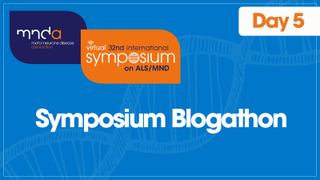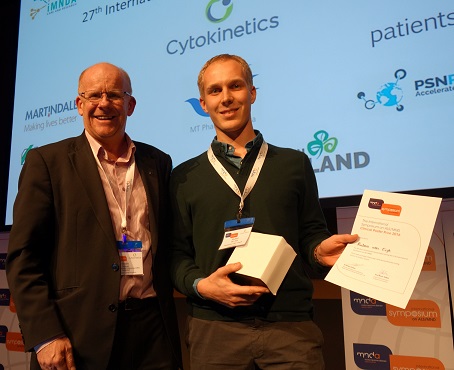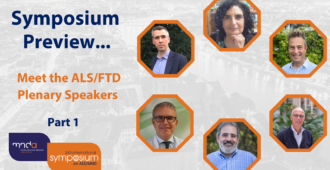This is blog number 5 in our ‘Symposium Blogathon’ – counting down to the 32nd International Symposium on ALS/MND. Numbers in bold green text correspond to the code in the abstract book. Click on the number to be redirected to the full abstract (the page may take a minute to load).
The phenotype is the set of observable characteristics or traits of an individual resulting from the interaction of its genotype – their genetic make-up, or complete set of genes – with the environment.
MND is traditionally described as a degenerative disease that selectively affects upper and lower motor neurons and is fatal 3-5 years after onset – a description that suggests that the clinical presentation of MND, or phenotype, is very ‘homogenous’, or that every individual’s disease course is very alike. However, clinical and post-mortem observations, as well as genetic studies, strongly suggest that there is considerable variability – or heterogeneity – in MND phenotypes. The same phenotypes can have multiple causes, including different gene mutations, but conversely, multiple phenotypes can be caused by a single genetic mutation.
Determining the phenotypes of individuals with MND is becoming ever more important with the advent of personalised medicines and gene therapies. Deeper analysis of data from clinical trials is revealing that ‘one size fits all’ is no longer an acceptable outcome, and that treatments may be more effective for some subgroups of participants than others. Identifying patients by their phenotypes may lead to the development of more successful clinical trials, help to speed up diagnosis and result in more accurate prognosis estimation.
RELATED TOPIC
Blog | 13 October 2017 | Dr Brian Dickie
Lithium revisited: Is there a baby in the bathwater?
MND can range from the classic amyotrophic lateral sclerosis, which involves upper and lower motor neurons, to forms that affect only the upper motor neurons (UMN) or lower motor neurons (LMN), and therefore have different characteristics. While it is widely accepted that these phenotypes have distinct survival rates, their disease course and clinical decline is still largely unknown. Additionally, most prognostic studies have focused mainly on classic ALS.
Researchers in Italy have looked to define specific disease courses over time, across the main MND phenotypes and to develop phenotype-specific prognostic models. Sixty patients with a clinical diagnosis of MND (26 classic ALS, 14 involving UMNs, 20 involving LMNs) were recruited and followed over a period of time with clinical evaluations approximately every three months for up to 15 months. Assessments were made using ALSFRS-R, muscle strength and UMN involvement. Cognitive and behavioural assessments were also taken.
Over time, greater changes in ALSFRS-R scores were seen in people with classic ALS. In classic ALS, significant predictors of a more aggressive decline included greater baseline rates of overall functional impairment and UMN involvement. In people with predominantly UMN involvement, significant predictors of a more aggressive decline over time were male gender and side of symptom onset, and in people with LMN involvement, greater baseline cognitive impairment and more severe mood disturbances. This study confirms the urgent need for phenotype-specific prognostic models to improve patient management and inclusion in clinical trials (DSP-09).
The same researchers further discuss the importance of determining which clinical features at the time of diagnosis help to differentiate between the three phenotypes mentioned above, to ensure appropriate subgrouping for clinical trial enrolment, clinical management and prognosis estimation in poster DSP-16.
As discussed, clinical presentation of MND is variable, with heterogeneity observed in age at symptom onset, progression to disease milestones and speed of overall disease progression. The mechanisms behind this variability are not well understood, making predicting an individual’s disease course challenging.
Data were collected as part of the Adelphi Disease Specific Programme (ADSP) by researchers in the USA and UK. The ADSP is a point-in-time survey of neurologists and their patients with MND across Europe, the UK and USA, carried out between July 2020-March 2021. This included age at symptom onset, genetic testing status and result and ALSFRS-R scores. One hundred and forty-two neurologists completed questionnaires for 880 people with MND, of whom 192 had a known genetic test result for both SOD1 and C9orf72 mutations (SOD1 positive – 34; C9orf72 positive – 17; non-SOD1/C9orf72 – 141).
While some heterogeneity was identified across the various genetic variants of MND, the overall results were largely non-significant indicating that age of onset and time to key milestones were largely equivalent across the overall MND population, and that all forms of the disease are severe. The rate of ALSFRS-R score decline per month showed some differences with the genetic variants, with the biggest difference seen in the C9orf72 group, which showed faster progression.
These subtle differences in MND presentation and progression highlight the complexity of understanding the disease course of MND and may contribute to delays in diagnosis and difficulty predicting symptom progression with individual patients. The results are discussed fully in poster DSP-12.
Stay informed
If you have come across this blog through the Symposium website, or a general search please subscribe (see top right hand corner of page) and you’ll be notified every time we upload a new article.
You can follow our research account on Twitter. We tweet about up to the minute research and will be tweeting throughout the Symposium – #alsmndsymp #drivingmndresearch
Take a look at the schedule of blogs for November as we continue counting down to the 32nd International Symposium on ALS/MND with our ‘Symposium Blogathon’.
To listen to talks live, take part in the Q&As and visit the live poster sessions, register for the International Symposium now.







